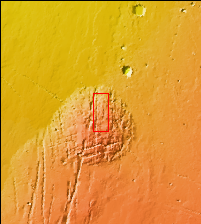
|
Ulysses Fossae
- Click the image above for a larger view
- Full-Res JPEG (694 x 1430) (96.2 kB)
- Full-Res TIFF (694 x 1430) (749.7 kB)
Caption:

Context image
Today's VIS image shows part of Ulysses Fossae, which is located in the Tharsis Volcanic region. The linear features are referred to as graben and are formed by extension of the crust and faulting. When large amounts of pressure or tension are applied to rocks on timescales that are fast enough that the rock cannot respond by deforming, the rock breaks along faults. In the case of a graben, two parallel faults are formed by extension of the crust and the rock in between the faults drops downward into the space created by the extension. Numerous sets of cross cutting graben are visible in this THEMIS image, indicating that this region underwent stresses in multiple directions. Ulysses Fossae is 850km (528 miles) long.
Orbit Number: 85956 Latitude: 16.8572 Longitude: 238.487 Instrument: VIS Captured: 2021-04-30 22:17
Background Info:
Please see the THEMIS Data Citation Note for details on crediting THEMIS images.
NASA's Jet Propulsion Laboratory manages the 2001 Mars Odyssey mission for NASA's Science Mission Directorate, Washington, D.C. The Thermal Emission Imaging System (THEMIS) was developed by Arizona State University, Tempe, in collaboration with Raytheon Santa Barbara Remote Sensing. The THEMIS investigation is led by Dr. Philip Christensen at Arizona State University. Lockheed Martin Astronautics, Denver, is the prime contractor for the Odyssey project, and developed and built the orbiter. Mission operations are conducted jointly from Lockheed Martin and from JPL, a division of the California Institute of Technology in Pasadena.
Cataloging Keywords:
| Name | Value | Additional Values |
|---|---|---|
| Target | Mars | |
| System | ||
| Target Type | Planet | |
| Mission | 2001 Mars Odyssey | |
| Instrument Host | Mars Odyssey | |
| Host Type | Orbiter | |
| Instrument | Thermal Emission Imaging System (THEMIS) | |
| Detector | ||
| Extra Keywords | Grayscale, Thermal, Volcano | |
| Acquisition Date | ||
| Release Date | 2021-10-04 | |
| Date in Caption | 2021-04-30 | |
| Image Credit | NASA/JPL-Caltech/ASU | |
| Source | photojournal.jpl.nasa.gov/catalog/PIA24211 | |
| Identifier | PIA24211 | |
